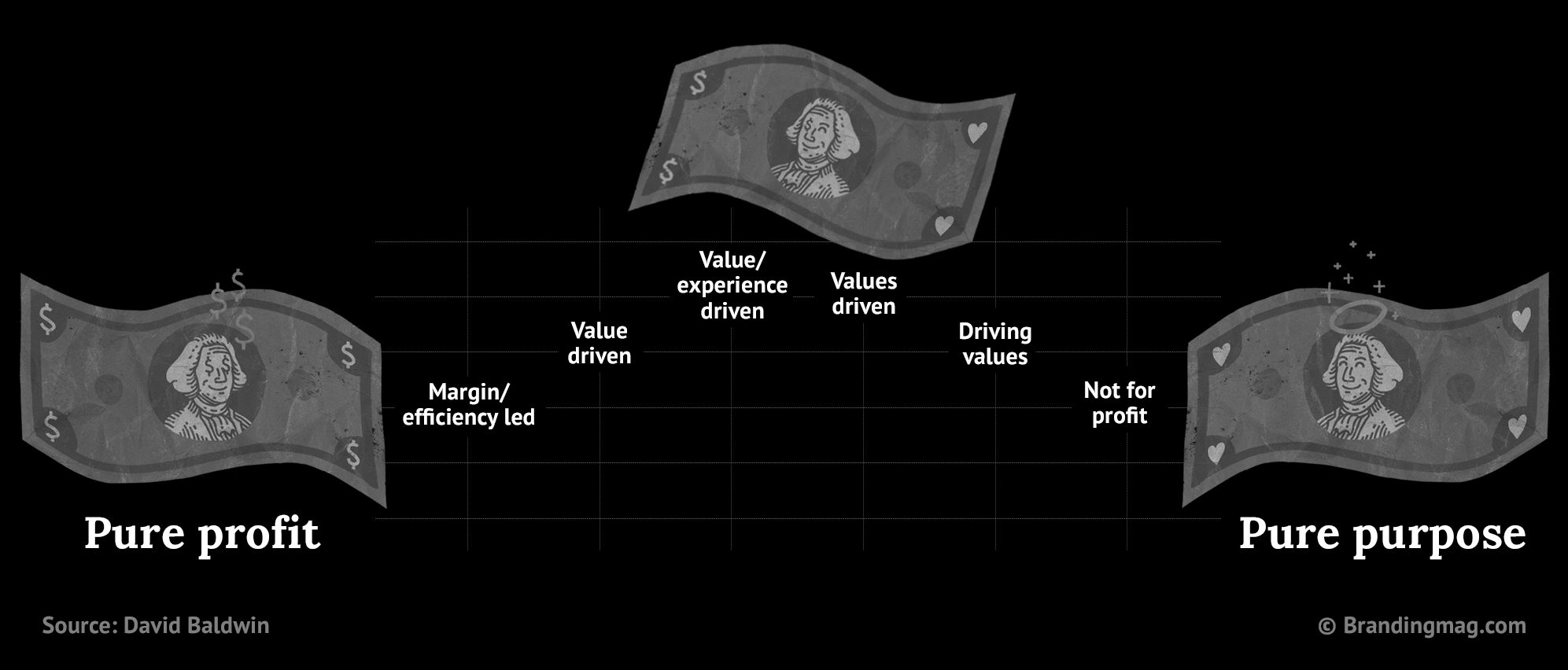
It seems that we live in a black and white world more and more these days. Right/Left, Red/Blue, Liberal/Conservative, Woke/Racist. But as we know from our real lives things are rarely this polarized. I believe it was The Monkees who sang Shades of Gray to a lonely, muted trumpet playing a pensive line.
What we actually experience is a sea of nuance on almost everything. The purpose debate is no different. The problem is we’ve driven it into a polarized conversation.
Many of the detractors of purpose think of it only as social justice, brand activism and nothing else. Come to think of it, many of the adherents think of it in the same way: standing up against the evils of industry and capitalism and therefore, anti-profit. Neither of these poles are very helpful, and the truth is very different.
Purpose, like everything, lives on a spectrum. Without profit, purpose is irrelevant for a business because, um, no business. But without purpose a business will not be able to operate as efficiently as possible.
So what if we relook at the idea of purpose as a spectrum that can carry everything?
In my book, The Belief Economy I talked mostly on the side where brands could make a meaningful contribution and societal change, what Michael Porter called “shared value.” In retrospect, I left out the more pragmatic side of purpose. If I wrote another book I’d certainly add a chapter on the idea of purpose as a holistic, defining force for a brand that can drive a company and its employees, its products, and its culture – no matter where it lives on the spectrum. Purpose is an action and behavior driven by a set of values. If you only care about profit and nothing else, there’s certainly nothing wrong with that at all, but it will define the culture, how you treat people, and how you regard the end customer.
So knowing where your brand lives on the purpose spectrum is crucial to success because many brands on the pragmatic side of this framework try to wade into the social good side and have no culture or systems in place to do it, and therefore, no permission, and then get a good whacking for it – with a capital G, G for Gillette.
Your company must do the work of your purpose first, and talk about it second.
So let’s talk about this spectrum in a little more detail. Is your purpose to prioritize profit over everything at the expense of anything? That’s still a purpose. A helpful framework is a scale from pure profit to pure purpose. (Man, those P’s are stacking up like cordwood in the marketing lexicon.)
Here’s a way to look at it:
 Most categories have a spectrum of brands across this framework. To demonstrate let’s look at fashion/apparel. Keep in mind that none of these distinctions are meant to imply inferior service or products.
Most categories have a spectrum of brands across this framework. To demonstrate let’s look at fashion/apparel. Keep in mind that none of these distinctions are meant to imply inferior service or products.
Pure profit:
- Margin/efficiency led. A brand that makes a minimum investment to maximize profit of a product or service, essentially the customer is just being offered a good deal. Ex: Shien. The benefits here are cheap, affordable products.
- Value driven. A brand that invests in quality product/service (great value) on behalf of the customer. Ex: Vuori (most quality fashion brands) The benefit to the customer is value – good stuff for a good price.
- Value/experience driven. A brand that invests in an idea, feeling or experience and a quality product/service for the customer. Ex: Lululemon. The benefit is a great brand experience and great products.
- Values driven. A brand that invests in a quality product/service/experience and uses the proposition to sometimes drive philanthropy(ies) for change on behalf of customers and to maximize profit. We start to see shared value. Here it’s feeling like you’re sometimes doing something good with your money or supporting a sector that’s important to you. Ex: Nike’s support of Colin Kaepernick
- Driving values. A brand that invests in a quality product/service/experience to further a social/environmental cause, in essence the cause is sometimes the lead marketing message. Ex: Patagonia, Everlane, Tom’s Shoes. The shared value here is being a part of change by enjoying a great product.
Pure purpose:
- Mission led, not for profit business. A brand that invests in a product/service entirely to fund a cause or organization (non-profit). Ex: Parks Project. The shared value here is community investment in something with no expectation of profit.
You’ll notice on the pure purpose side of things we’re not talking about for-profit businesses anymore, rather NGO’s, churches, public endeavors and the like.
Where do you land on the spectrum?
How do you know where your company lies on the spectrum? (It’s probably pretty clear, let’s be honest.)
First, how are you articulating your brand and your mission? Second, are you actually living that articulation with consistent behavior? In essence, are you being who you say you are? Probably a topic for another article, but it’ll certainly be evident to your own people and quite possibly to your customers whether you are or you are not. Why not consistently ask them?
If you do want to move your brand from pure profit to the pure purpose side of the framework you’ll need to do the work first. Spend time on your company from the inside out, articulate your mission clearly to your people and your customers. Don’t let it just live in your marketing department.
It’s so simple, just be who you say you are.
Cover image source: rosinka79